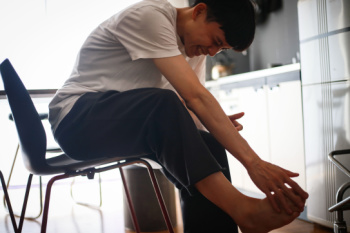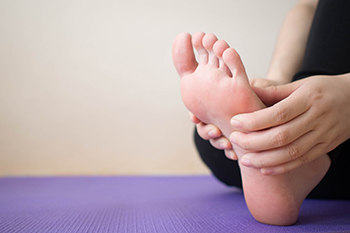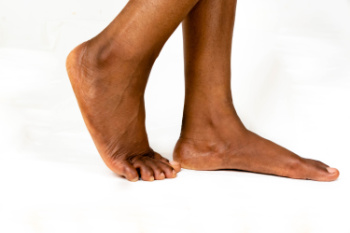Blog
Items filtered by date: May 2025
Managing Gout With Ongoing Treatment

Gout is a chronic inflammatory form of arthritis that often affects the joints of the feet, particularly the big toe. During a gout flare-up, the affected joint may become intensely painful, swollen, and red due to the buildup of uric acid crystals. While there is no cure for gout, medical treatment can help reduce the frequency and intensity of flare-ups and limit joint damage. A podiatrist can diagnose gout and recommend treatment options that lower uric acid levels and manage inflammation. These may include medication that reduces pain and swelling, as well as long-term prescriptions aimed at preventing recurrences. Without proper treatment, gout may lead to joint deformity or permanent damage in the feet or ankles. Timely care from a podiatrist can shorten flare-ups, which typically peak within 24 hours and may last several days. If you suffer from flare-ups of gout, it is suggested that you schedule regular appointments with a podiatrist for ongoing treatment.
Gout is a foot condition that requires certain treatment and care. If you are seeking treatment, contact Akena Wannamaker, DPM from ASW Foot and Ankle. Our doctor will treat your foot and ankle needs.
What Is Gout?
Gout is a type of arthritis caused by a buildup of uric acid in the bloodstream. It often develops in the foot, especially the big toe area, although it can manifest in other parts of the body as well. Gout can make walking and standing very painful and is especially common in diabetics and the obese.
People typically get gout because of a poor diet. Genetic predisposition is also a factor. The children of parents who have had gout frequently have a chance of developing it themselves.
Gout can easily be identified by redness and inflammation of the big toe and the surrounding areas of the foot. Other symptoms include extreme fatigue, joint pain, and running high fevers. Sometimes corticosteroid drugs can be prescribed to treat gout, but the best way to combat this disease is to get more exercise and eat a better diet.
If you have any questions, please feel free to contact our office located in Richmond, VA . We offer the newest diagnostic and treatment technologies for all your foot care needs.
Why Feet Cramp During Sleep

Foot cramps that strike during sleep can be sudden, painful, and hard to ignore. They often affect the arch or toes and may last just a few seconds or several minutes. These cramps can be caused by dehydration, low mineral levels, poor circulation, or muscle fatigue from daytime activity. Sleeping with feet pointed or in a tight position may also trigger cramping. Stretching your feet and calves before bed, staying well hydrated, and wearing loose socks at night may help prevent episodes. Gently massaging or flexing the foot can ease the pain when a cramp occurs. If cramps become frequent or repeatedly interfere with sleep, it is suggested you see a podiatrist for appropriate treatment.
Foot Pain
Foot pain can be extremely painful and debilitating. If you have a foot pain, consult with Akena Wannamaker, DPM from ASW Foot and Ankle. Our doctor will assess your condition and provide you with quality foot and ankle treatment.
Causes
Foot pain is a very broad condition that could be caused by one or more ailments. The most common include:
- Bunions
- Hammertoes
- Plantar Fasciitis
- Bone Spurs
- Corns
- Tarsal Tunnel Syndrome
- Ingrown Toenails
- Arthritis (such as Gout, Rheumatoid, and Osteoarthritis)
- Flat Feet
- Injury (from stress fractures, broken toe, foot, ankle, Achilles tendon ruptures, and sprains)
- And more
Diagnosis
To figure out the cause of foot pain, podiatrists utilize several different methods. This can range from simple visual inspections and sensation tests to X-rays and MRI scans. Prior medical history, family medical history, and any recent physical traumatic events will all be taken into consideration for a proper diagnosis.
Treatment
Treatment depends upon the cause of the foot pain. Whether it is resting, staying off the foot, or having surgery; podiatrists have a number of treatment options available for foot pain.
If you have any questions, please feel free to contact our office located in Richmond, VA . We offer the newest diagnostic and treatment technologies for all your foot care needs.
Causes and Treatment of Flat Feet

Flat feet occur when the arches of the feet are low or absent, causing the soles to make full contact with the ground while standing. Flat feet may be present from childhood or develop later from weakened tendons, ligament injuries, fractures, or arthritis. Some people with flat feet have no symptoms, but others experience aching in the arches, heels, ankles, or discomfort that extends to the knees and lower back. A podiatrist can diagnose flat feet by examining foot posture and gait, and may use imaging tests to evaluate the bones and soft tissues. When flat feet cause pain, medical treatment options include wearing custom orthotics or specially designed supportive footwear to reduce strain. In more severe cases, surgery may be recommended to strengthen or realign the affected structures in the feet. Early medical care can help manage symptoms and prevent further complications. If flat feet are disrupting your daily activities, it is suggested that you schedule an appointment with a podiatrist for appropriate treatment options.
Flatfoot is a condition many people suffer from. If you have flat feet, contact Akena Wannamaker, DPM from ASW Foot and Ankle. Our doctor will treat your foot and ankle needs.
What Are Flat Feet?
Flatfoot is a condition in which the arch of the foot is depressed and the sole of the foot is almost completely in contact with the ground. About 20-30% of the population generally has flat feet because their arches never formed during growth.
Conditions & Problems:
Having flat feet makes it difficult to run or walk because of the stress placed on the ankles.
Alignment – The general alignment of your legs can be disrupted, because the ankles move inward which can cause major discomfort.
Knees – If you have complications with your knees, flat feet can be a contributor to arthritis in that area.
Symptoms
- Pain around the heel or arch area
- Trouble standing on the tip toe
- Swelling around the inside of the ankle
- Flat look to one or both feet
- Having your shoes feel uneven when worn
Treatment
If you are experiencing pain and stress on the foot you may weaken the posterior tibial tendon, which runs around the inside of the ankle.
If you have any questions, please feel free to contact our office located in Richmond, VA . We offer the newest diagnostic and treatment technologies for all your foot care needs.
Definition and Causes of Shuffling Gait

A shuffling gait is a walking pattern where a person takes small, dragging steps without lifting the feet fully off the ground. This abnormal gait can indicate underlying health conditions and often suggests issues with balance, coordination, or muscle control. One possible cause is ataxia, a neurological condition that impairs coordination and makes smooth walking difficult. Ataxia may result from damage to the cerebellum or other parts of the nervous system. Another related condition is foot drop, where weakness or paralysis in the muscles that lift the front of the foot causes dragging during walking. This can stem from nerve injuries or disorders affecting the muscles or spine. Identifying the cause of a shuffling gait is essential for effective treatment, improved mobility, and prevention of further complications. If you have a shuffling gait, it is suggested that you are under the care of a podiatrist who can help you to monitor this condition.
When dealing with systemic disease of the feet, it is extremely important to check the affected areas routinely so that any additional problems are caught quickly. If you have any concerns about your feet and ankles contact Akena Wannamaker, DPM from ASW Foot and Ankle. Our doctor will assist you with all of your podiatric needs.
Systemic Diseases of the Feet
Systemic diseases affect the whole body, and symptoms usually are displayed in the feet. This condition can make a patient’s ability to walk unbearable. Systemic diseases include gout, diabetes mellitus, neurological disorders, and arthritis.
Gout – is caused by an excess of uric acid in the body. Common symptoms include pain, inflammation, and redness at the metatarsal/phalangeal joint of the base big toe. Gout can be treated by NSAIDs to relieve pain and inflammation, and other drugs that lower the acid levels in the body.
Diabetes mellitus – is an increase in the level of blood sugar that the body cannot counteract with its own insulin. Failure to produce enough insulin is a factor in Diabetes.
Diabetes of the Feet
Diabetic Neuropathy – may lead to damaged nerves and affect the feet through numbness and loss of sensation.
Peripheral Vascular Disease – can restrict the blood flow to the feet, and often times lead to amputation of the feet.
If you have any questions please contact our office located in Richmond, VA . We offer the newest diagnostic and treatment technologies for all your foot and ankle needs.
